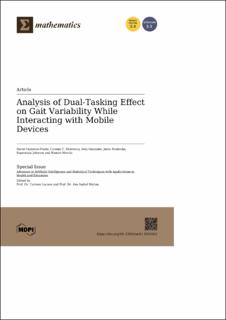| dc.contributor.author | Carneros-Prado, David | |
| dc.contributor.author | Dobrescu, Cosmin C. | |
| dc.contributor.author | González, Iván | |
| dc.contributor.author | Fontecha, Jesús | |
| dc.contributor.author | Johnson Ruiz, Maria Esperanza | |
| dc.contributor.author | Hervás, Ramón | |
| dc.date.accessioned | 2024-04-03T09:09:06Z | |
| dc.date.available | 2024-04-03T09:09:06Z | |
| dc.date.created | 2023-12-14T10:40:43Z | |
| dc.date.issued | 2023 | |
| dc.identifier.issn | 2227-7390 | |
| dc.identifier.uri | https://hdl.handle.net/11250/3124618 | |
| dc.description | This article is an open access article distributed under the terms and conditions of the Creative Commons Attribution (CC BY) license (https://creativecommons.org/licenses/by/4.0/). | en_US |
| dc.description.abstract | Cognitive deficits are very difficult to diagnose during the initial stages; tests typically consist of a patient performing punctual dual-task activities, which are subjectively analyzed to determine the cognitive decline impact on gait. This work supports novel and objective diagnosis methods by stating a baseline on how neurotypical aging affects dual tasks while using a smartphone on the move. With this aim, we propose a twofold research question: Which mobile device tasks performed on the move (dual tasking) have characteristic changes in gait parameters, and which are especially characteristic at older ages? An experiment was conducted with 30 healthy participants where they performed 15 activities (1 single task, 2 traditional dual-tasks and 12 mobile-based dual-tasks) while walking about 50 m. Participants wore a wireless motion tracker (15 sensors) that made the concise analysis of gait possible. The results obtained characterized the gait parameters affected by mobile-based dual-tasking and the impact of normal cognitive decline due to aging. The statistical analysis shows that using smartphone-based dual-tasking produces more significant results than traditional dual-tasking. In the study, 3 out of 10 gait parameters were very significantly affected (p < 0.001) when using the traditional dual tasks, while 5 out of 10 parameters were very significantly affected (p < 0.001) in mobile-based dual-tasking. Moreover, the most characteristic tasks and gait parameters were identified through the obtained results. Future work will focus on applying this knowledge to improve the early diagnosis of MCI. | en_US |
| dc.language.iso | eng | en_US |
| dc.publisher | MDPI | en_US |
| dc.rights | Navngivelse 4.0 Internasjonal | * |
| dc.rights.uri | http://creativecommons.org/licenses/by/4.0/deed.no | * |
| dc.title | Analysis of Dual-Tasking Effect on Gait Variability While Interacting with Mobile Devices | en_US |
| dc.title.alternative | Analysis of Dual-Tasking Effect on Gait Variability While Interacting with Mobile Devices | en_US |
| dc.type | Peer reviewed | en_US |
| dc.type | Journal article | en_US |
| dc.description.version | publishedVersion | en_US |
| dc.rights.holder | © 2022 by the authors. Licensee MDPI, Basel, Switzerland | en_US |
| dc.source.volume | 11 | en_US |
| dc.source.journal | Mathematics | en_US |
| dc.source.issue | 1 | en_US |
| dc.identifier.doi | 10.3390/math11010202 | |
| dc.identifier.cristin | 2213485 | |
| dc.source.articlenumber | 202 | en_US |
| cristin.ispublished | true | |
| cristin.fulltext | original | |
| cristin.qualitycode | 1 | |

